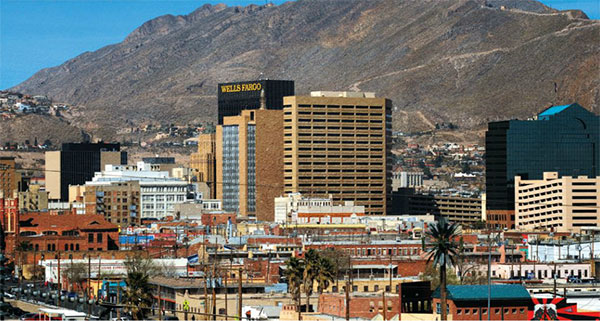Texas Bucks the Trends
HOLA,NEIGHBOR: EL PASO AS SEEN FROM MEXICO
Nearsourcing allows Texas companies to make quick production changes instead of “the long fight to Asia.”
Open space? You knew that about the sprawling Lone Star state. Let us tell you about its high-tech smarts and global business savvy
Of course, we think of Texas as a mere extension of the American frontier, if not quite cowboys then maybe oilmen. The truth is that Texas is high-tech, a relentlessly ambitious and forward-looking state larger than France and as smart as . . . . Well, let Federal Reserve Bank of Dallas president and CEO Richard W. Fisher tell you: “Texas’s transition from a resource-based economy built on cattle, cotton and oil to a knowledge-based economy built on human capital and innovation is our greatest success . . . . We are quick to usher in the new.”
Take FibeRio Technology Corp., a manufacturer now operating in McAllen where it assembles and tests its nanofiber production equipment—equipment that evolved from technology developed at the University of Texas Pan American (UTPA).
Not just the equipment: FibeRio itself is a product of UTPA’s business incubation program. Already the company has shipped its system to Kertak Nanotechnology, a leading manufacturer of ceramic nanofibers in the Czech Republic.
Key factors that influenced the company to locate in McAllen: availability of abundant suppliers and service providers on both sides of the border, competitive city incentives, and proximity to the knowledge base that developed this technology at UTPA.
“McAllen provides the perfect setting for a technology company with a manufacturing operation serving a global market,” says Ellery Buchanan, president and CEO of FibeRio. “The McAllen Economic Development Corp. makes doing business in the region simple and effective. The business-friendly UTPA provides talented graduates. The region simply has everything to attract business.”
A GOLD WIND BLOWING
“Amarillo is expected to create a substantial number of new wind-power projects over the next several years.”
French company Alstom Wind, a global leader in power generation, picked a location at the other end of Texas, in Amarillo. It operates its first—and so far only—North American manufacturing facility, producing the generator, gearbox, and control systems that make up a wind turbine.
“Amarillo is the ideal location for Alstom’s wind power manufacturing hub in North America because it is centrally located in an area that is expected to create a substantial number of new wind-power projects over the next several years,” says Alfonso Faubel, Alstom Wind’s vice president.
Another plus: Alstom’s location is rail served, meaning it can easily transport its massive equipment to sites across North America. Two Burlington Northern Santa Fe Railway (BNSF) main rail lines intersect at Amarillo and provide direct service to Chicago, Los Angeles, Denver, Phoenix, Kansas City, Dallas, Seattle, Vancouver, Memphis, St. Louis and Pensacola. These also terminate at the ports of Houston, San Diego and Galveston. The Union Pacific-Southern Pacific railroad also has rights to use BNSF tracks in the Amarillo area.
X-Fab Texas Inc. in Lubbock exemplifies Texas innovation, operating one of the few remaining semiconductor foundries in the United States. Last year, the company partnered with Minnesota-based Cymbal Corp. to open the world’s highest volume solid-state battery production facility in Lubbock.
“This EnerChip solid-state battery fabrication facility extends our manufacturing capabilities into new cutting-edge technologies,” says Lloyd Whetzel, X-Fab president and CEO.
NEW DIRECTIONS
The Federal Reserve’s Fisher identifies other factors that contribute to Texas’s ability to adapt to the changing export landscape. These include low tax and regulatory burdens, flexible labor markets, open land availability, tort reform, world-class seaports, airports and transportation and communication infrastructure, and the fact that there’s employment opportunity for people to come work here and better themselves.
“These factors have contributed to a low cost of living and have made doing business in Texas much easier,” Fisher says. “In fact, a worker can move from high-tech centers like the Silicon Valley or Boston to major Texas cities like Dallas or Austin, and both the company and the worker will be economically better off.”
That was the case for Xeris, an early-stage biopharmaceutical company. In May the company announced its relocation from Larkspur, California to Austin where it joined the growing number of life-science companies choosing the Texas capital as their home.
Dr. John Kinzell, CEO of Xeris, reveals that after evaluating six states and nine metro areas, his company chose Austin because of quality of life, lower business costs, science cluster, continual ranking as one of the top entrepreneurial cities in the United States, and top research university UT Austin.
“In the end, I came to believe that Austin had what it would take to allow our company to attract C-suite executives and scientists from both coasts,” Kinzell says.
San Antonio is also a magnet for the life sciences—one of the fastest-growing industry sectors in Central Texas and a key focus for the state. In June 2011, BD (aka Becton, Dickinson and Co.), a leading global medical technology company headquartered in New Jersey, opened its new North American Professional Service Center in San Antonio as part of its global strategy to establish four professional services headquarters throughout the world.
Other clusters targeted by the state are aerospace/aviation, advanced manufacturing, distribution/logistics, energy/environmental tech, financial services, IT/cybersecurity, information technology, and nanotechnology.
Consequently, Texas is attracting a fair share of foreign direct-investment. In 2010, Triangle Studios, a Dutch developer of applications and games, opened an office in Dallas to be closer to U.S. customers and promote international growth. That same year, UK-based Oil Careers Ltd. chose Houston for its first office in North America to serve the U.S. and Canadian markets. Huawei Technologies USA (a unit of China-based Huawei Technologies Co., Ltd., a global telecommunications company) expanded its Plano facility to include a customer demonstration center, test lab, and a technical assistance center.
 WORLD CLASS ENTERTAINMENT
WORLD CLASS ENTERTAINMENT
“A worker can move from a high-tech center like the Silicon Valley to Dallas or Austin, and both the company and the worker will be economically better off.”
Infrastructure Assets
SomnoMed, Inc., an Australia-based company that manufactures and distributes medical devices for the treatment of sleep disorders, also relocated its North American corporate headquarters to Frisco.
“Dallas/Fort Worth International Airport (DFW) is one of the major reasons international companies look at our area,” says Kathleen Stewart, spokesperson for the Frisco EDC.
DFW adds more than $14 billion to the North Texas economy annually. No huge surprise there: it’s the third-busiest airport in the world for both passenger and cargo traffic, and handles more than 60 percent of all Texas cargo. From DFW, shippers can reach more than 50 million consumers within 24 hours by truck. DFW has 12 air cargo carriers serving 14 global destinations in Latin America, Asia, Europe, and Australia.
American Airlines, which flies extensively throughout most of the world, operates one of its five hubs at DFW. The airline and its cargo operations are headquartered in Fort Worth.
The city is also home to the world’s first 100 percent industrial airport, Fort Worth Alliance Airport, where FedEx operates its Southwest Regional Sort hub. An indicator of Alliance’s success: cargo volumes increased 24 percent in 2010 over 2009.
Houston George Bush Intercontinental Airport (IAH) is also critical to businesses in the state. Among foreign carriers operating there, Qatar Airways recently launched dedicated freighter service to IAH. The carrier is largely hauling industrial components and equipment for the oil/gas sector. In August 2012, Lufthansa will inaugurate A380 service to Houston.
IAH is the largest hub for United Continental Holdings, now the biggest air carrier in the world. IAH is undergoing a $1 billion terminal renovation to accommodate the airline.
In addition, IAH offers one million square feet of cargo space with capacity to handle perishables, oilfield equipment, computers, auto parts and other vital shipments safely and efficiently.
Even more significant, the Port of Houston is a catalyst for growth of both imports and exports. The port is ranked No. 1 in the United States for both foreign waterborne tonnage and imports. More than 220 million tons of cargo moved through the Port in 2009, the result of over 7,700 vessel calls.
Increased trade with China has fueled not only cargo volumes at the seaport, but also given rise to a number of large distribution centers in the region. Wal-Mart operates a massive 4-million-square-foot distribution center in the Houston Ship Channel area. Home Depot also has a 750,000-square-foot distribution facility near Baytown.
Jim Edmonds, chairman of the Port of Houston Authority (PHA), attributes this big-box retailer investment to the 60-plus million people who live within 700 miles of Houston.
Going forward, the port will also play an increasingly important role when the Panama Canal expansion project is completed in 2014 and ships begin arriving from Asia that would otherwise stop at the West Coast or steam through the Suez Canal.
Texas companies also benefit from a strong interstate system that feeds the nation and the NAFTA corridor from Mexico to Canada. The BNSF and Union Pacific (UP) rail networks that have major operation nodes throughout the state.
Trade Microcosm
No discussion of Texas would be complete without mention of border activity between Texas and Mexico. Here, companies enjoy relations between maquiladoras, or twin plants, that offer operational and labor force cost advantages.
“Mexico’s advantage for Texas is nearsourcing, as opposed to a company buying from China that might have to wait 30 days for the product,” remarks Sheila Hewitt, vice president of Transplace, an international 3PL based in Frisco. “Companies can enjoy a much more compressed timeline and address issues fairly quickly as opposed to having to make the long flight to Asia.”
But civil war in some parts of Mexico has produced a countervailing trend: companies that might have chosen to manufacture in Mexico are opting, instead, to expand into Texas.
In addition, the region is seeing increased activity in traditional industries such as food processing, plastics injection molding, and textile manufacturing.
“Many companies are interested in both importing and exporting from here,” says Gilberto Salinas, executive vice president of the Brownsville EDC. “Any company in the world can get product into Brownsville by rail, truck, international bridge, or sea.”
A good example is Santana Textiles in nearby Edinburg, which recently commenced operation of its first denim production line. Their story is simple: Santana wanted to meet the demand for “Made in the USA” denim and do it in the most cost-effective location possible.
The cut-and-sew portion of Santana’s operation is done in other locations, while the denim is produced in the United States, thus having enough of a U.S. component to meet customer demand for U.S. products.
“Rio South Texas was ideal for them,” says Raudel Garza, executive director of the Rio South Texas Economic Council. “We are strategically located to distribute to all points in the United States and to receive finished goods from Mexico and other parts of Latin America.”
It turns out that when you’re in Texas, you’re in the global economy.





Leave a Reply